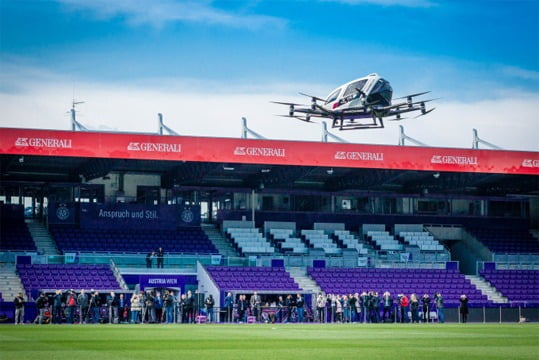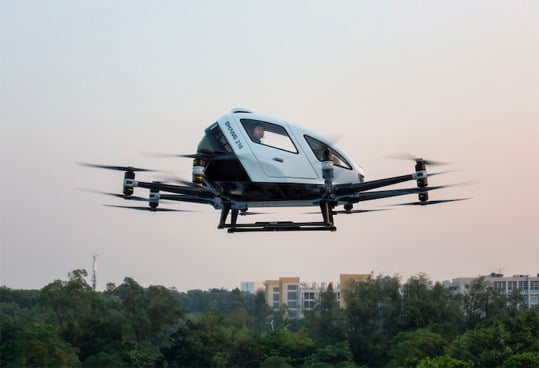
Totally electric passenger cars have also arrived in Greece, although charging infrastructure is still limited. (In Bulgaria, proportionally, there are noticeably more charging points). It’s a matter of time – and money.
However, don’t rush to buy an electric car. For quite a few more years, internal-combustion engines won’t be banned. And in the meantime, the future will bring flying cars – you know the unstoppable machine’s interest in this (from a capitalist point of view) revolutionary type…
So, let’s lay it out. Guangzhou is the avant-garde tech-city of Chinese capitalism, an Asian Silicon Valley multiplied—minus the forest fires all around…. EHang is a Chinese avant-garde flying-vehicle company, way ahead of any global competitors, in the sense that it has been conducting exhaustive tests on its vehicles for years to forge the ultimate “safety software.”
EHang is ready for the global market of this type; however, it still needs something equally important: the hardware and software of urban air-traffic management for such vehicles, which in the future will number in the tens of millions. This is a colossal technological prerequisite, since in 3D urban traffic the problems we know from 2D (on the roads) are not simply cubed…
So: EHang is preparing to install the relevant technology in Guangzhou, in cooperation with the local authorities, with the prospect that flights of private flying cars, taxis and cargo-delivery drones will be manageable in a rational way (based on a low-altitude air-traffic control program) by 2021. In roughly two years from today… And because some people may be sentimental and consider Guangzhou distant and irrelevant, an exactly similar program has already started, in cooperation with Vodafone, in the German city of Düsseldorf – which is definitely closer.

What do these mean, whether they develop in faraway China or in nearby Germany? The technological core of this internet of things, where flying vehicles will communicate with multiple automatic and semi-automatic “urban flight control centers” and also with each other, is the creation of 5G applications for these specific needs. We needn’t remind anyone which capitalist company is the leader in 5G technologies; some (pro-Americans—they live among us!) may shudder, and we don’t want that.
The conclusion, in any case, is indisputable: long before the children who are now toddlers finish primary school, privately used electric land vehicles will have begun to take on the shade of a relic. Much earlier—certainly in Guangzhou (we don’t know about Düsseldorf…)—urban take-off/landing zones, parking, and whatever else is needed for the flying gizmos will have been built. In fact, they will be ready within the next 1.5 years.
From this point of view, those who live in Kypseli (for example) won’t enter this capitalist phase; so they don’t have the related worries either. From the perspective of urban height, the also urban underworld (its soil and its subcultures) is inevitable. Here and there some levelling may become necessary, some famine, some havoc – something anyway: the gentrifications of the not-so-distant future will serve not two but all three dimensions of urban displacements.
Will the cities of modern urban planning/spatial development be destroyed? Or will they simply decline, as is already happening, only far more intensively? The truth is that in capitalist developments the losers are many—regardless of the form the loss takes…
(photo above: EHang demonstrates its vehicles on a field in Vienna last April – to European journalists and flight experts. They were impressed, it is said…
Below: a walk in the forest. From a safe distance…)
